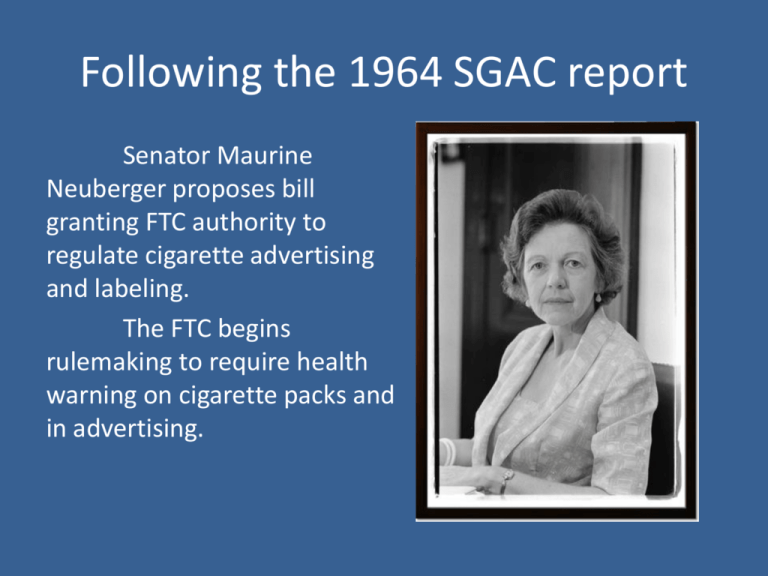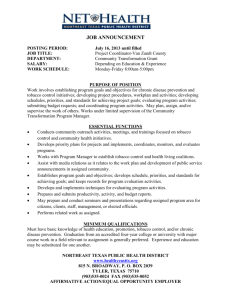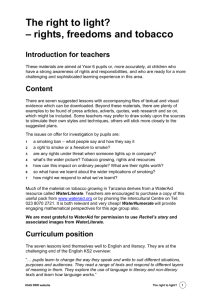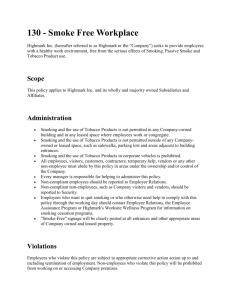1970 - Tobacco Exhibits
advertisement

Following the 1964 SGAC report Senator Maurine Neuberger proposes bill granting FTC authority to regulate cigarette advertising and labeling. The FTC begins rulemaking to require health warning on cigarette packs and in advertising. American Medical Association The American Medical Association accepts a $10 million grant for tobacco research from six cigarette companies. The AMA shelves its previous plans to issue a report on smoking's relationship to cancer instead they suggest , "More than 90 million persons in the United States use tobacco in some form, and, of these 72 million use cigarets... the economic lives of tobacco growers, processors, and merchants are entwined in the industry; and local, state, and the federal governments are recipients of and dependent upon many millions of dollars of tax revenue.“ In 1965 the U.S. Public Heath Service establishes National Clearing house for Smoking and Health Warning Labels: Cigarette Smoking May Be Hazardous to Your Health In 1966 Congress requires Health Warnings on Cigarette packs. Needed picture of first warning label 1967 The Surgeon General’s second Report: By William H. Stewart FTC’s evaluation of warning Labels FTC’s evaluation of advertising Why Television Advertisements were banned: The Fairness Doctrine In late 1966 John Banzaf inquired to see if a local television station, WCBS-TV, would provide air time for announcements against smoking. The station being sponsored by tobacco refused. Banzhaf filed a complaint, stating the FCC's fairness doctrine required broadcasters to provide free air time to opposing views of matters of public controversy . On June 2, 1967, the FCC announced its decision that the fairness doctrine applied to the request for anti-smoking announcements. The FCC stated that the public should hear an anti-smoking viewpoint. However, the FCC required only the ratio of one antismoking message for each four cigarette advertisements (not the oneto-one ratio suggested by Banzhaf). Various governmental and voluntary health organizations made extremely creative spots and provided them to stations. In response, tobacco companies offered to self regulate and stop all advertising on television. Tobacco ads ceased to appear on television at the end of 1970. John Banzaf went on to establish Action on Smoking an Health Warning Labels: Adds Surgeon General Title “Warning the Surgeon General has Determined that Cigarette Smoking is Dangerous to your Health.” Great American Smoke Out Nov 16th 1977 The American Cancer Society held its first Smokeout in San Francisco's Union Square. The event challenges people to stop smoking cigarettes for 24 hours, hoping their decision not to smoke will last forever. TWA Goes Smokefree 1977 Doctors Ought to Care (DOC) Drs. Alan Blum and Rick Richards founded Doctors Ought to Care and begin the first paid marketing campaign against the tobacco industry. Doc had chapters of activist all over the nation. They tried to shift the focus off of individual smokers and onto the tobacco industry. The Doc would make house calls to tobacco sponsored events like the Virginia Slims Tennis Tournament. Joseph Califano In a 1979 report Health Education and Welfare Secretary Joseph Califano announces a “vigorous” anti-smoking campaign on the 14th anniversary of the first Surgeon General’s report. Surgeon General Julius Richmond The Health Consequences of Smoking In the 1980 Surgeon General Report stated, “The is no such thing as a safe cigarette.” FAMRI Flight attendants’ testimony helps end smoking on commercial flights. In 1981 the Federal Trade Commission concludes that health warning labels have had little effect on public knowledge and attitudes about smoking. Program Analyst of the FTC Matt Meyers considered tobacco advertising to be more detrimental Passive Smoking Environmental Tobacco Smoke (ETS) The Hirayama Study Takeshi Hirayama, an epidemiology at the Tokyo's National Cancer Center, follows 92,000 nonsmoking wives of smoking husbands for fourteen years to learn there risk of contracting lung cancer greatly increase. Cipollone In 1983 Rose Cipollone filed a law suit against Philip Morris, the Liggett Group and Lorillard, one year later she died. Warning Label: Rotation The Federal Cigarette Labeling and Advertising Act was amended to require that one of the four warning labels listed below appears in a specific format on cigarette packages and in most related advertising. • SURGEON GENERAL'S WARNING: Smoking Causes Lung Cancer, Heart Disease, Emphysema, And May Complicate Pregnancy. • SURGEON GENERAL'S WARNING: Quitting Smoking Now Greatly Reduces Serious Risks to Your Health. • SURGEON GENERAL'S WARNING: Smoking By Pregnant Women May Result in Fetal Injury, Premature Birth, and Low Birth Weight. • SURGEON GENERAL'S WARNING: Cigarette Smoke Contains Carbon Monoxide. Surgeon General Everett Koop's 1986 report, The health consequences of involuntary smoking “Second-hand smoke is not just as an annoyance but as a quantifiable health risk. It was estimated that passive smoking contributed to 50,000 deaths a year in the U.S.” The next year Congress banned smoking on all domestic flights under two hours and extended it to all domestic flights two years later. 1988, The Reason For Continued Smoking Is Redefined Clean Indoor Air Act Enacted in 1989 in New York State and amended in 2003, this law currently prohibits smoking of tobacco nearly all public and work places. The U.S. Environmental Protection Agency in 1992 concluded ETS caused Lung Cancer Whistle Blowers Victor J. DeNoble Philip Morris Scientist Ex-Philip Morris scientist Victor J. DeNoble testifies on his research into nicotine and addiction in rats; claims PM suppressed his findings. Joseph Bumgarner RJ Reynolds Scientist. “they started out with the best of intentions…and then something scared them.” Jeffrey Wigand Brown and Williamson Scientist New York Times released a front-page article concerning "secret" Brown & Williamson tobacco papers, which Stanton . Glantz at UCSF receives from "Mr. Butts.” Mississippi Attorney General Mike Moore was the first Attorney General to commence litigation. Other states and insurance companies joined the class-action suits to recover medical costs of tobacco-caused disease. Waxman Committee 1994 Exhibit 6195 A New York State Judge places The TOBACCO INSTITUTE and the COUNCIL FOR TOBACCO RESEARCH under temporary receivership, in response to a state suit charging the organizations abused their tax-exempt status under New York law, where they were incorporated, by acting as tobacco -funded "fronts" that serve "as propaganda arms of the industry." Master Settlement Agreement November 1998 The Tobacco Master Settlement Agreement (MSA) a court case between the four largest US tobacco Companies and the attorney general of 46 states. The states settled their Medicaid lawsuits against the tobacco industry; the companies agreed to curtail certain tobacco marketing practices. as well as to pay, in perpetuity, various annual payments of a minimum of $206 billion over the first twenty-five years of the agreement. Tobacco Industry Documents are released 1997-12-18: Rep. Tom Bliley (R-VA) posts 843 sensitive Liggett documents on House Commerce Committee website. 1998-01-14: LITIGATION: MANGINI Documents Released. RJR documents that appear to discuss targeting youths as young as 14 create a furor. 1998-04-22: 39,000 super-secret documents are posted on the House Commerce committee web site Taking Down Joe Camel Joe Camel Ads violates federal law MSA MONEY Legacy Tobacco Documents Library Internal documents from the major US tobacco industry companies and organizations comprise the bulk of the Legacy Tobacco Documents Library. These documents were made available through litigation brought by the National Association of Attorneys General (NAAG) that resulted in the Master Settlement Agreement (1998) Tobacco Free Kids In 1996, Mr. Matt Myers helped to found the Campaign for Tobacco-Free Kids Smokefree Housing Quitlines By 1999, it appeared both that the tobacco industry had lied to the American people about the risks of smoking, and that it would not effectively be punished for its lies. The lawsuit United States v. Philip Morris, et. al., commenced on September 21, 2004. In 2006 U.S. District Judge Gladys Kessler ruled in favor of the federal government in its massive RICO case against the tobacco companies alleging that they engaged in misleading conduct for decades as part of a broad conspiracy. FDA Regulates Tobacco Products The Family Smoking Prevention and Tobacco Control Act, United States federal law that gives the FDA the power to regulate the tobacco industry. A signature element of the law imposes new warnings and labels on tobacco packaging and their advertisements, the act gives the FDA authority to regulate new tobacco products. Warning Labels: Graphic References Books • Gene Borio tobacco timeline • Richard Kluger’s Ashes to Ashes • Tobacco Encyclopedia Interviews by • Dr. Cummings • Dr. Blum • Eric Solberg • Victor Denoble/ addiction incorporated video excerpts. Videos • Tobacco Wars • Tobacco Conspiracy • Tobacco Institute Video Collection Documents • legacy • tobaccodocuments.org






